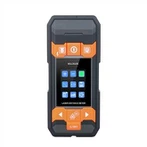Infrared thermometer system introduces three aspects of classification and selection
Infrared system:
Infrared thermometer is composed of optical system, photoelectric detector, signal amplifier, signal processing, display output and other parts. The optical system gathers the infrared radiation energy of the target in its field of view, and the size of the field of view is determined by the optical parts of the thermometer and its position. Infrared energy is focused on a photodetector and converted into a corresponding electrical signal. The signal passes through the amplifier and the signal processing circuit, and is converted into the temperature value of the measured target after being corrected according to the algorithm of the internal treatment of the instrument and the emissivity of the target.
The selection of infrared thermometer can be divided into three aspects:
Performance indicators, such as temperature range, spot size, working wavelength, measurement accuracy, response time, etc.; environmental and working conditions, such as ambient temperature, window, display and output, protection accessories, etc.; other options, such as ease of use, maintenance And calibration performance and price, etc., also have a certain impact on the choice of thermometer. With the continuous development of technology and technology, the best design and new progress of infrared thermometers provide users with various functions and multi-purpose instruments, expanding the choice.
Determine the temperature range:
The temperature measurement range is the most important performance index of the thermometer. For example, Raytek products cover the range of -50°C-+3000°C, but this cannot be done by one type of infrared thermometer. Each type of thermometer has its own specific temperature range. Therefore, the user's measured temperature range must be considered accurately and comprehensively, neither too narrow nor too wide. According to the law of blackbody radiation, the change of radiation energy caused by temperature in the short-wave band of the spectrum will exceed the change of radiation energy caused by emissivity error. Therefore, it is better to use short-wave as much as possible when measuring temperature.
Determine target size:
Infrared thermometers can be divided into single-color thermometers and two-color thermometers (radiation colorimetric thermometers) according to the principle. For monochromatic thermometers, when measuring temperature, the area of the target to be measured should fill the field of view of the thermometer. It is recommended that the measured target size exceed 50% of the field of view. If the target size is smaller than the field of view, the background radiation energy will enter the visual and acoustic symbols of the thermometer and interfere with the temperature measurement readings, causing errors. Conversely, if the target is larger than the pyrometer's field of view, the pyrometer will not be affected by background outside the measurement area.
Determining Optical Resolution (Distance and Sensitivity)
The optical resolution is determined by the ratio of D to S, which is the ratio of the distance D between the pyrometer to the target and the diameter S of the measuring spot. If the thermometer must be installed far away from the target due to environmental conditions, and a small target must be measured, a thermometer with high optical resolution should be selected. The higher the optical resolution, that is, the higher the D:S ratio, the higher the cost of the thermometer.
Determine the wavelength range:
The emissivity and surface properties of the target material determine the spectral response or wavelength of the pyrometer. For high reflectivity alloy materials, there is low or varying emissivity. In the high temperature area, the best wavelength for measuring metal materials is near infrared, and the wavelength of 0.18-1.0μm can be selected. Other temperature zones can choose 1.6μm, 2.2μm and 3.9μm wavelength. Since some materials are transparent at a certain wavelength, infrared energy will penetrate these materials, and a special wavelength should be selected for this material. For example, the wavelengths of 10 μm, 2.2 μm and 3.9 μm are used to measure the internal temperature of the glass (the measured glass must be very thick, otherwise it will pass through) wavelengths; The wavelength of 3.43 μm is used for measuring polyethylene plastic film, and the wavelength of 4.3 μm or 7.9 μm is used for polyester. If the thickness exceeds 0.4mm, choose 8-14μm wavelength; another example is to measure C02 in the flame with a narrow band of 4.24-4.3μm wavelength, measure C0 in the flame with a narrow band of 4.64μm wavelength, and measure N02 in the flame with a wavelength of 4.47μm.
Determine response time:
Response time indicates the reaction speed of the infrared thermometer to the measured temperature change, which is defined as the time required to reach 95% of the energy of the final reading, which is related to the time constant of the photodetector, signal processing circuit and display system. The response time of bytek's new infrared thermometer can reach 1ms. This is much faster than the contact temperature measurement method. If the moving speed of the target is very fast or when measuring a fast-heating target, a fast-response infrared thermometer should be selected, otherwise the sufficient signal response will not be achieved and the measurement accuracy will be reduced. However, not all applications require a fast-response infrared thermometer. For stationary or target thermal processes where thermal inertia exists, the response time of the pyrometer can be relaxed. Therefore, the choice of the response time of the infrared thermometer should be adapted to the situation of the measured target.






